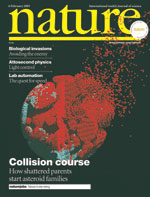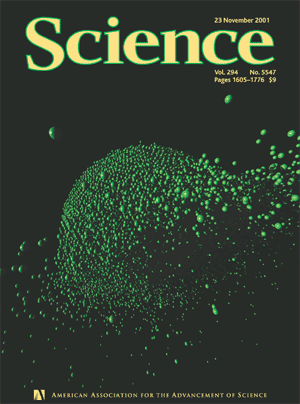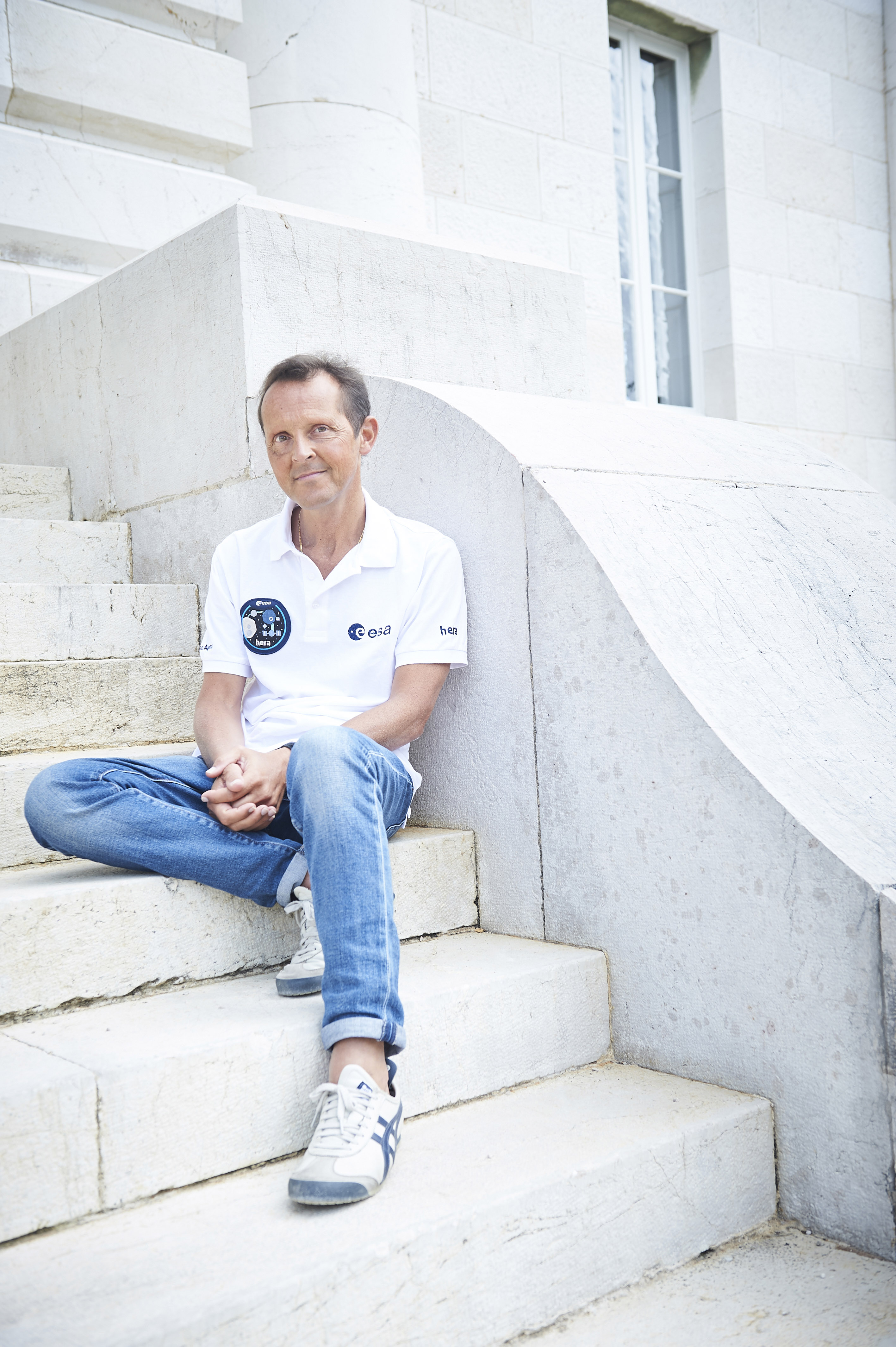Patrick Michel: Collisions entre astéroides.
mise à jour le 6 Février 2003
COLLISIONS ENTRE ASTEROIDES:
CORPS PARENTS PRE-FRAGMENTES A L'ORIGINE DES
FAMILLES D'ASTEROIDES
Michel, P., Benz, W., Richardson, D.C. 2003. Nature 421, 608-611.
Des simulations de collisions entre astéroïdes efectuées par Patrick Michel (Laboratoire UMR6529 Cassini/CNRS, Observatoire de la Côte d'Azur) et ses collaborateurs des Université de Berne (Suisse) et Maryland (USA) ont permis pour la première fois de fournir des indications sur la structure interne des astéroïdes et notamment d'établir que les corps parents à l'origine des familles d'astéroïdes étaient déjà pré-fragmentés (remplis de fractures et/ou de vide, et non monolithiques) avant d'être chacun détruit pour former une famille (Michel, P., Benz, W., Richardson, D.C. 2003. Fragmented parent bodies as the origin of asteroid families. Nature Vol. 461, pp. 608-611). Les simulations montrent alors que la formation d'une famille se produit à l'issue de la destruction d'un tel corps constitué de roches empilées, générant des centaines de milliers de fragments, dont certains pourront même devenir des astéroïdes potentiellement dangereux et des météorites. ![]() Cliquer ici pour obtenir l'article en fichier pdf.
Cliquer ici pour obtenir l'article en fichier pdf.
De plus, les résultats montrent que l'énergie d'impact nécessaire pour produire un résultat donné lors d'une collision dépend fortement de la structure interne de la cible, et cela constitue une information importante pour élaborer des stratégies de défense face à la menace d'un impact avec la Terre.
Ces travaux sont publiés dans le journal Nature daté du 6 Février 2003 (Michel, P., Benz, W., Richardson, D.C. 2003. Fragmented parent bodies as the origin of asteroid families. Nature 421, 608-611) et ont fait l'objet de la couverture du journal et d'un Communiqué de Presse du CNRS (cliquer pour y accéder).
 Michel, P., Benz, W., Richardson, D.C. 2003. Nature Vol. 461, 608-611.
Michel, P., Benz, W., Richardson, D.C. 2003. Nature Vol. 461, 608-611.
Légende de la couverture: More than 20 asteroid families have been identified in the main asteroid belt, each the result of collisional break-up of a much larger parent body. The recently discovered Karin family of asteroids is relatively young (from a collision that took place about 5 million years ago) and unaffected by orbital evolution. This provides an opportunity to deduce details of the internal structure of the parent bodies from observational data. Numerical simulations of the Karin collision suggest the parent body was itself internally fragmented and that the collision produced thousands of fragments, perhaps including near-Earth asteroids and meteorites.
Des vidéos et images des simulations de collisions peuvent être obtenus en cliquant sur cette ligne.
Les simulations de collisions que les chercheurs avaient effectuées précédemment avaient permis de mettre en évidence le rôle de la fragmentation et de la ré-accumulation gravitationnelle dans la formation des familles d'astéroïdes (Michel, P., Benz, W., Tanga, P., Richardson, D.C. 2001. Collision and gravitational reaccumulation: forming asteroid families and satellites. Science 294, 1696-1700).
Ces travaux ont aussi fait l'objet de la couverture du journal Science et d'un: Communiqué de Presse du CNRS (22 novembre 2001)
 Michel, P., Benz, W., Tanga, P., Richardson, D.C. 2001. Science Vol. 294.
Michel, P., Benz, W., Tanga, P., Richardson, D.C. 2001. Science Vol. 294.
Légende de la Couverture (en Anglais): Simulated image of the disruption of a 100-km asteroid. Collisions between large asteroids generate as many as 50,000 kilometer-sized fragments, some of which will eventually reaccumulate to form aggregates. 1696 [Image: P. Michel and P. Tanga]
COLLISIONS BETWEEN ASTEROIDES:
FRAGMENTED PARENT BODIES AS THE ORIGIN OF
ASTEROID FAMILIES
Michel, P., Benz, W., Richardson, D.C. 2003. Nature 421, 608-611.
Simulations of collisions between asteroids have been performed by Patrick Michel (Laboratoire UMR6529 Cassini/CNRS, Observatoire de la Côte d'Azur) and his collaborators from the University of Berne (Switzerland) and Maryland (USA) and have allowed for the first time to obtain some indications on the internal structure of asteroids. In particular, the results suggest that parent bodies of asteroid families were originally pre-fragmented (filled with fractures and/or voids, and not monolithics) before being each disrupted to form a family. Simulations then show that the formation of a family is produced by the disruption of such a "rubble pile", generating hundreds of thousands of fragments, among which some will eventually beacome near-Earth asteroids and meteorites.
Moreover, the results show that the impact energy needed to produce a given result from a collision highly depends on the internal structure of the target. this is a major information in order to elaborate mitigation strategies stratégies in case of the potential impact of an asteroid with the Earth.
This research is published in the journal Nature of February 6th, 2003 (Michel, P., Benz, W., Richardson, D.C. 2003. Fragmented parent bodies as the origin of asteroid families. Nature 421, 608-611) and the image of a simulation illustrates the cover of the journal.
 Michel, P., Benz, W., Richardson, D.C. 2003. Nature Vol. 421, 608-611. (Click here for a pdf copy)
Michel, P., Benz, W., Richardson, D.C. 2003. Nature Vol. 421, 608-611. (Click here for a pdf copy)
Cover Legend: More than 20 asteroid families have been identified in the main asteroid belt, each the result of collisional break-up of a much larger parent body. The recently discovered Karin family of asteroids is relatively young (from a collision that took place about 5 million years ago) and unaffected by orbital evolution. This provides an opportunity to deduce details of the internal structure of the parent bodies from observational data. Numerical simulations of the Karin collision suggest the parent body was itself internally fragmented and that the collision produced thousands of fragments, perhaps including near-Earth asteroids and meteorites.
Simulations of collisions already performed by these researchers had already allowed to characterize the role of the fragmentation and of the gravitaional re-accumulation in the formation of asteroid families (Michel, P., Benz, W., Tanga, P., Richardson, D.C. 2001. Collision and gravitational reaccumulation: forming asteroid families and satellites. Science 294, 1696-1700).
This work had also illustrated the cover of the journal Science and of a press release: communiqué de presse du CNRS (22 novembre 2001)
 Michel, P., Benz, W., Tanga, P., Richardson, D.C. 2001. Science Vol. 294.
Michel, P., Benz, W., Tanga, P., Richardson, D.C. 2001. Science Vol. 294.
Cover Legend: Simulated image of the disruption of a 100-km asteroid. Collisions between large asteroids generate as many as 50,000 kilometer-sized fragments, some of which will eventually reaccumulate to form aggregates. 1696 [Image: P. Michel and P. Tanga]





